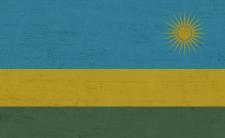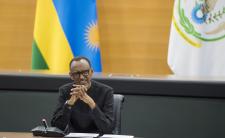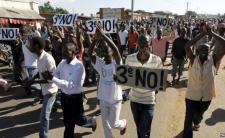The Republic of Rwanda is landlocked country in the great lakes region of Central Africa bordered by the Democratic Republic of Congo, Tanzania, Burundi and Uganda. It has a population of over 10 million belonging to two principal ethnic groups – the Hutus (majority) and the Tutsis (minority). In April 1994, Rwanda attracted international attention for being the stage of a mass wave of genocidal ethnic cleansing not seen since the holocaust. Following a diplomatic spat over assignment of blame for the 1994 genocide and subsequent severance of relations with France, the regime of Paul Kagame started a policy of Anglicization, which saw a significant shift from French cultural traditions towards Anglo-Saxon culture. As a result, Rwanda joined the British Commonwealth and English, was introduced as the official language together with Kinyarwanda, while French was progressively relegated.
Political system and history
Rwanda was a German colony from 1883 until 1919 when it was converted to a League of Nations Mandate Territory following Germany's defeat by Allied Forces at the end of the First World War. Belgium formally accepted to administer the mandate territory on behalf of the League of Nations in 1923. Following the establishment of the United Nations Organisation (UN) at the end of the Second World War, all mandate territories were converted to trust territories wherein Belgium then held Rwanda on trust for the UN with the obligation to prepare it towards independence. The Belgians adopted the administrative policy of indirect rule which was based on an ascriptive classification of humans into inferior and superior beings. Accordingly, the conclusion was somehow reached that the Hutu majority was less fit for leadership than the tustsi minority who were then used to indirectly implement Belgian administrative policy. In 1959, an unprecedented Hutu revolution dismantled Tutsi aristocracy resulting in a massive wave of emigration of the latter into neighbouring Congo, Uganda and Burundi. Subsequent elections and independence in 1962 will see – Gregoire Kayibanda - a Hutu become the first president of Rwanda. This was the beginning of a Hutu hegemony that will transcend the establishment of the second republic in 1973, under Juvenal Habyarimana, until civil war and external winds of change in the 1990s eventually swept Paul Kagame – a tustsi and leader of the rebel Rwandan Patriotic Front (RPF) into power in 1994. This effectively ended almost 30 years of dictatorship, tribalism and ushered in a new political and constitutional order. The presidential system was maintained with a bicameral legislature.
Constitutional history and development
Like many former colonies, Rwanda - before 1994 - had never had a constitution that can truly be described as autochthonous. Many reasons account for this. For instance, existing constitutions were based on foreign models which never took into account the sociological configuration and perculiarities of the Rwandan nation. Secondly, Rwandans never participated in the making of these constitutions as they were simply imposed on them by the foreign occupiers.
Rwanda's constitutional development can be divided into three phases: the independence or decolonization phase, post independence phase, and the 1990s.
Constitution building and decolonization
The 1961 Constitution
This constitution was established in the context of the decolonisation processes and transition to independence. It was essentially a product of the Hutu Revolution that eclipsed Belgian supported Tutsi dominance. Increasing ethnic violence between the Hutus and the Tutsis who wanted independence from Belgium based on the prevailing Tutsi Monarchy eventually forced Belgium to organise elections in 1960. The result was a massive Hutu win which saw a dramatic shift in the power structure in favour of the Hutus. Following a Belgian supported constitutional referendum in 1961, a constitution that effectively abolished the Tutsi monarchy, and established a republic was adopted with Dominique Mbonyumutwa as head of the transisitional government.
The Constitution of 1962
In November 1962, a new constitution was adopted. Its main objective was to consolidate the republic and establish a multiparty regime. The de facto situation, however, was a one party system in which the Rwandan Democratic Movement (MDR Parmehutu) dominated the political scene and ruled alone. In 1973, Juvenal Habyarimanna took power in a military coup, arguing that the old regime had become corrupt, ineffective and riddled with favouritism. The constitution was suspended and he effectively ruled by decrees until 1978 when a new charter was drawn up.
The Post independence or One party State Constitutional Development
The Constitution of 1978
This constitution replaced the 1962 constitution and made very little improvements in terms of democratic governance. It formally replaced the pluralist regime established by the previous charter with a one party system. According to article 40 of this constitution, only the National Revolutionary Movement for Development (MNRD) and its Chairman could run for president.
Post Cold War or Multi Party Constitutional Development
The 1991 Constitution
The end of the cold war and the disintegration of the Soviet Union in 1990 provoked a massive wave of democratization in Eastern Europe that eventually spread, amongst other places, to Africa. With Soviet competition out of the picture, Western donor governments started adopting conditionalities to their development support programmes, as aid became tied to rule of law, good governance and democratic reforms. Within Rwanda, other dynamics were taking place that would combine with this to force the regime to reform. In October 1990, the Uganda-based, and Tutsi dominated RPF invaded Rwanda and demanded a share in power. These dynamics combined to force Habyarimanna to introduce liberal reforms. In 1991, a constitutional revision reintroduced multi party politics. It upheld the principle of separation of powers and the rule of law. This constitution however was never effectively applied because a civil war that had been going on since 1990 provoked a parallel process that supplemented the internal reforms with a negotiated settlement on the war between the main actors. This was the Arusha Peace Accords of August 1994, which together with the 1991 constitution and additional protocols on the rule of law, constituted the fundamental law of Rwanda during the transitional period from 1994 to 2003.
The 2003 Constitutional reform process
The Arusha Accords provided for a broad based power sharing government and the drafting of a new constitution that would govern the post transition period. As a result, a constitutional Commission was established with a three year mandate to drive the process which had to be participatory and grounded in the aspirations of the Rwandan People. The Commission was charged to:
- Train, consult and sensitize the people on the process of constitution making; prepare and validate the draft bill;
- Organise a referendum on the text when approved by parliament, and,
- Harmonise all laws in the new constitution.
The Rwandan process has been criticised for being mostly driven by the Kagame led government following its victory in the civil war that claimed the lives of over 800,000 Rwandan Tutsis together with that of President Juvenal Habyarimanna. This notwithstanding, the process is credited for producing the first true constitution written by Rwandans and based on their common aspirations and interests. It was adopted in a constitutional referendum in 2003 and remains in force. Innovative features of the constitution include: a National Unity and Reconciliation Commission set up to reverse effects of bad governance through education and to fight against the genocide ideology. Similarly institutions (Commissions for Women, Youth, Civil Service, Genocide Fighting, Education High Council, etc.) promoting good governance were provided for, as a response to the long period of bad governance that led to genocide. The Gacaca judicial system was instituted in the Constitution. The writing of the Rwandan constitution was also engendered not only in the process but also in its substance. It introduced a strong gender policy based on principles of equality and human rights, requiring at least 30 percent representation of women in all decision making processes.
Key timelines in the 2003 constitutional process
| August 1993 | Arusha Accords signed to end the civil war that started in 1990 and establishes a 9 year transition |
| Early 1994 | President Habyarimanna intimates his intention to disregard the Accords calling it a mere scrap of paper and war resumes as RPF returns to the bush |
| 6 April 1994 | President Habyarimanna is assassinated provoking massive extermination campaign against Tutsis |
| July 1994 | RPF defeats Hutu dominated government forces and declares their intention to honour the Arusha Accord. Loose coalition government is formed |
| 2000 | Kagame elected president by a single party parliament and embarks on a constitutional reforms. A Legal and constitutional Commission with three year mandate is established to drive the process |
| May 2003 | Rwandans back draft constitution in a referendum vote |
| Branch | Hierarchy | Powers | Removal |
|---|




Share this article